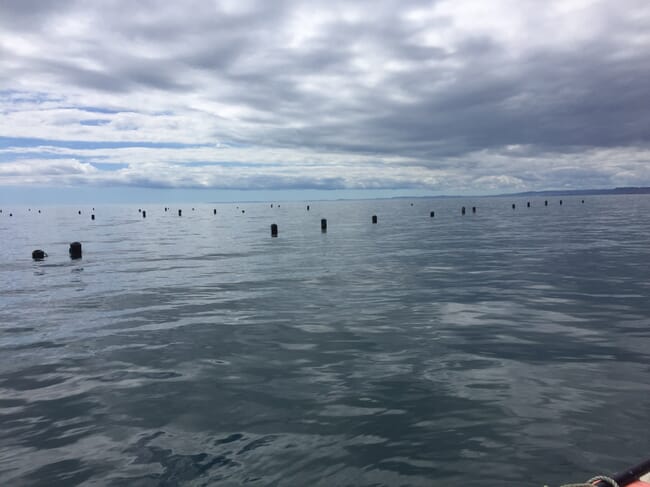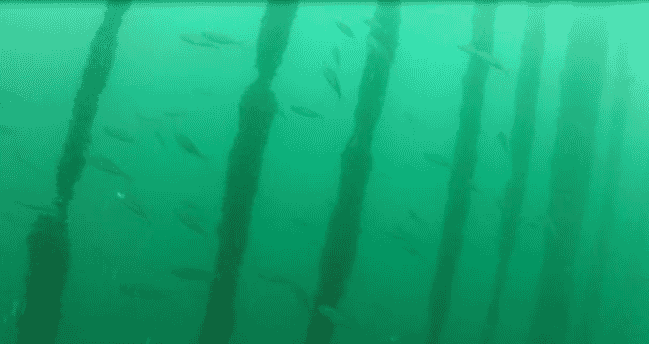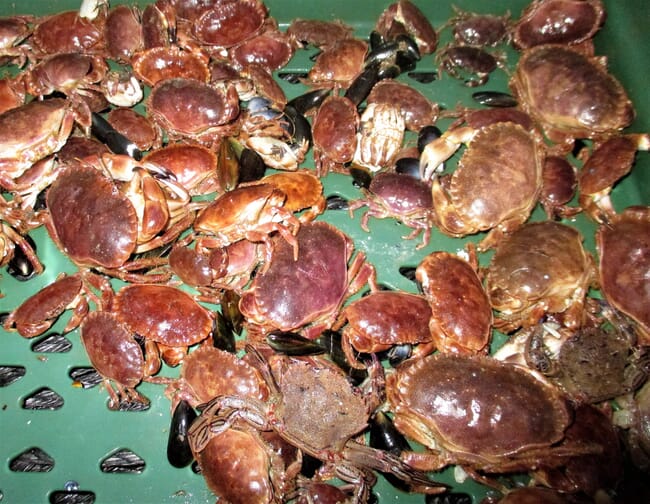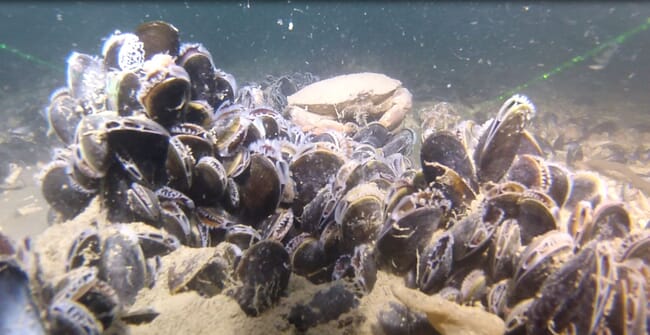Led by Dr Emma Sheehan from Plymouth University, the project is investigating the impact that Europe’s biggest mussel farm is having on the surrounding ecosystem. Although the farm – which aims to produce 10,000 tonnes of the bivalves a year by 2020 – is not yet complete, the investigation has so far produced extremely encouraging results, particularly in relation to biodiversity.
Danielle Bridger is a PhD student studying the ecological impact of the farm. “During the project we have set up four research stations in the farm, four control stations located 500m from the farm, and four more 4km from the farm,” she explains. “So far, stations within the farm have picked up much more evidence of life, and it’s particularly encouraging to find species such as brown crab, scallops and lobster are thriving at the site.”

© Danielle Bridger
When plans to establish the mussel farm – which is being run by Offshore Shellfish in Lyme Bay, off the south coast of Devon – were initially unveiled, many local fishermen voiced opposition to the idea; after all it was going to exclude them from 15 square kilometres of their traditional fishing grounds.
However, Danielle’s findings to date, as well as anecdotal evidence of increased catches in the vicinity of the mussel lines, have encouraged hopes that fishermen will soon see the value of the farm.
Studies on the impact of the farm have now been going on since 2013, and Danielle has been involved in the project since the start – first as a research assistant, which then evolved into her PhD – the results of which are due next year. And, over time, the project has evolved considerably from its original remit.
“Natural England required Offshore Shellfish to monitor the benthic impact of the mussels before they would consider issuing a full licence for the project,” says Danielle, “but we’ve since decided to record animals living on the ropes, mid-water fishes and larger vertebrates above the surface, including birds and dolphins.”

© Danielle Bridger
The communities growing on the ropes are currently being collected every few months and are awaiting analysis, while the mid-water survey is being undertaken with a video rig, which has been custom made by Plymouth University. Meanwhile the benthos is being monitored by three different video systems: a camera that can be towed behind a boat and can monitor activity around the edge of the site; baited video that attracts mobile marine organisms such as crabs and lobsters; and a remotely operated vehicle (ROV), which can be used to investigate the extent of mussel fall-out and the associated species that use it as their habitat. These are supported by the use of a Shipek grab to extract benthic sediments for an assessment of the infauna.
“Inshore mussel farms have a tendency to cause a shift in the communities in and around them,” Danielle observes, “and can create anoxic conditions under them in which the increase in organic material caused by falling mussels and faeces can create a loss of biodiversity.”
However, she says, this has not yet been the case at the Lyme Bay site.
“No detrimental effects on the benthic fauna have been found to date,” reflects Danielle, “and although there’s been a build-up of mussels beneath the site, these seem to be attracting more species such as crabs, lobsters, starfish, pout, plaice and horse mackerel. And the footage under the mussel lines makes the control site – where very few species have been detected – seem very bare by comparison.”
Although this may change when the mussel site reaches full capacity, concedes Danielle, for the moment it seems that mussel production is well below the carrying capacity of the location.

© John Holmyard
“The site has great water exchange and we’ve seen no build-up of faeces or the creation of bacterial mats so far,” Danielle explains.
If this continues to be the case after the site is running at full capacity for a decent amount of time, it will strengthen the case for growing more shellfish (and finfish) further offshore.
“If people see that such farming systems are less detrimental to the environment, and may even help increase biodiversity, the project could help promote offshore shellfish production,” points out Danielle, “and this fits in with the European drive for Blue Growth.”
However, only continued monitoring as the site grows will allow any definitive conclusions to be drawn.
“The research needs to continue as mussel production is not at even half the level it will be when the farm is complete,” says Danielle, “and it will be interesting to see what impact the site has when it’s running at full capacity.”

© Danielle Bridger
Partially as a result of this, and partially due to other ideas that she has come up with in the course of the current project, Danielle is very keen to remain involved in researching the impact of the operation as it grows.
“I’d like to continue to be involved once I’ve completed my PhD next year,” she says, “and one project I think could be particularly interesting would be tagging the brown crabs, which are returned to the water once the mussels have been harvested, to see where they end up.”
Such a project could help support the theory – which is increasingly popular among growers of shellfish and seaweeds – that aquaculture structures and the communities they support can act as valuable nursery habitats for a number of species. If this can be backed by solid research, even the most sceptical fishermen should start to back the emergence of such farms.
For more information please refer to www.sheehanresearchgroup.com or contact Danielle.bridger@plymouth.ac.uk; emma.sheehan@plymouth.ac.uk



